Skip to comments.
The Pascha miracle of Holy Fire appears at the tomb of Jesus Christ (pictures)
yahoo.com ^
| Sat Apr 10, 3:27 PM ET
Posted on 04/11/2004 1:46:16 AM PDT by Destro
The Pascha miracle of Holy Fire appears at the tomb of Jesus Christ (pictures)
 Christian worshipers surround what is traditionally believed to be the tomb of Jesus Christ, during the Holy Fire ceremony during Easter celebrations at the Church of the Holy Sepulchre in Jerusalem's Old City, Saturday, April 10, 2004. The ceremony is meant to assure the worshippers that Jesus has not forgotten them and is sending a message of hope through the fire. (AP Photo/Brennan Linsley)
Christian worshipers surround what is traditionally believed to be the tomb of Jesus Christ, during the Holy Fire ceremony during Easter celebrations at the Church of the Holy Sepulchre in Jerusalem's Old City, Saturday, April 10, 2004. The ceremony is meant to assure the worshippers that Jesus has not forgotten them and is sending a message of hope through the fire. (AP Photo/Brennan Linsley)
 Israeli police in blue uniforms push back pilgrims and Evzones, right, members of the Greek Presidential guard, who escorted Greek Orthodox Patriarch of Jerusalem Irineos I, unseen background right, as he exits the tomb, during scuffles in the Holy Fire ceremony at the Church of the Holy Sepulcher in east Jerusalem's Old City Saturday, April 10, 2004. Thousands of Christian Orthodox pilgrims wait outside the tomb, where Jesus Christ is traditionally believed to be buried, for hours until the Greek Orthodox Patriarch opens the doors carrying the holy flame which is then used to light all the other candles of the faithfull. (AP Photo/Lefteris Pitarakis)
Israeli police in blue uniforms push back pilgrims and Evzones, right, members of the Greek Presidential guard, who escorted Greek Orthodox Patriarch of Jerusalem Irineos I, unseen background right, as he exits the tomb, during scuffles in the Holy Fire ceremony at the Church of the Holy Sepulcher in east Jerusalem's Old City Saturday, April 10, 2004. Thousands of Christian Orthodox pilgrims wait outside the tomb, where Jesus Christ is traditionally believed to be buried, for hours until the Greek Orthodox Patriarch opens the doors carrying the holy flame which is then used to light all the other candles of the faithfull. (AP Photo/Lefteris Pitarakis)
 A Greek Orthodox monk, lights the candles of the tomb, where Jesus Christ is traditionally believed to be buried, with Holy Fire following the Holy Fire ceremony in the Church of the Holy Sepulcher at east Jerusalem's Old City Saturday, April 10, 2004. Thousands of Christian Orthodox pilgrims wait outside the tomb for hours until the Greek Orthodox Patriarch opens the doors carrying the holy flame which is then used to light all the other candles of the faithfull. (AP Photo/Lefteris Pitarakis)
A Greek Orthodox monk, lights the candles of the tomb, where Jesus Christ is traditionally believed to be buried, with Holy Fire following the Holy Fire ceremony in the Church of the Holy Sepulcher at east Jerusalem's Old City Saturday, April 10, 2004. Thousands of Christian Orthodox pilgrims wait outside the tomb for hours until the Greek Orthodox Patriarch opens the doors carrying the holy flame which is then used to light all the other candles of the faithfull. (AP Photo/Lefteris Pitarakis)
 A Russian Orthodox monk, lifts up candles with Holy Fire as crowds of orthodox Christian worshippers and clergymen light candles with Holy Fire from each other during a ceremony in the Church of the Holy Sepulcher in east Jerusalem's Old City Saturday, April 10, 2004. Thousands of Christian Orthodox pilgrims wait outside the tomb, where Jesus Christ is traditionally believed to be buried, for hours until the Greek Orthodox Patriarch opens the doors carrying the holy flame which is then used to light all the other candles of the faithfull. (AP Photo/Lefteris Pitarakis)
A Russian Orthodox monk, lifts up candles with Holy Fire as crowds of orthodox Christian worshippers and clergymen light candles with Holy Fire from each other during a ceremony in the Church of the Holy Sepulcher in east Jerusalem's Old City Saturday, April 10, 2004. Thousands of Christian Orthodox pilgrims wait outside the tomb, where Jesus Christ is traditionally believed to be buried, for hours until the Greek Orthodox Patriarch opens the doors carrying the holy flame which is then used to light all the other candles of the faithfull. (AP Photo/Lefteris Pitarakis)
 The lights of a candlelight procession leave trails as Christian worshippers surround what is traditionally believed to be the tomb of Jesus Christ, during the Holy Fire ceremony during Easter celebrations at the Church of the Holy Sepulchre in Jerusalem's Old City, Saturday, April 10, 2004. (AP Photo/Brennan Linsley)
The lights of a candlelight procession leave trails as Christian worshippers surround what is traditionally believed to be the tomb of Jesus Christ, during the Holy Fire ceremony during Easter celebrations at the Church of the Holy Sepulchre in Jerusalem's Old City, Saturday, April 10, 2004. (AP Photo/Brennan Linsley)
 Christian worshippers hold candles at the Holy Fire ceremony during Easter celebrations at the Church of the Holy Sepulchre in Jerusalem's Old City, Saturday, April 10, 2004. The ceremony is meant to assure the worshippers that Jesus has not forgotten them and is sending a message of hope through the fire. (AP Photo/Oded Balilty)
Christian worshippers hold candles at the Holy Fire ceremony during Easter celebrations at the Church of the Holy Sepulchre in Jerusalem's Old City, Saturday, April 10, 2004. The ceremony is meant to assure the worshippers that Jesus has not forgotten them and is sending a message of hope through the fire. (AP Photo/Oded Balilty)
 A Christian worshipper holds a candle at the Holy Fire ceremony during Easter celebrations at the Church of the Holy Sepulchre in Jerusalem's Old City, Saturday, April 10, 2004. The ceremony is meant to assure the worshippers that Jesus has not forgotten them and is sending a message of hope through the fire. (AP Photo/Oded Balilty)
A Christian worshipper holds a candle at the Holy Fire ceremony during Easter celebrations at the Church of the Holy Sepulchre in Jerusalem's Old City, Saturday, April 10, 2004. The ceremony is meant to assure the worshippers that Jesus has not forgotten them and is sending a message of hope through the fire. (AP Photo/Oded Balilty)
 Christian worshippers and clergymen light candles outside what is traditionally believed to be the tomb of Jesus Christ during the Holy Fire ceremony during Easter celebrations at the Church of the Holy Sepulchre in Jerusalem's Old City, Saturday, April 10, 2004. The ceremony is meant to assure the worshippers that Jesus has not forgotten them and is sending a message of hope through the fire. (AP Photo/Kevin Frayer)
Christian worshippers and clergymen light candles outside what is traditionally believed to be the tomb of Jesus Christ during the Holy Fire ceremony during Easter celebrations at the Church of the Holy Sepulchre in Jerusalem's Old City, Saturday, April 10, 2004. The ceremony is meant to assure the worshippers that Jesus has not forgotten them and is sending a message of hope through the fire. (AP Photo/Kevin Frayer)
 Orthodox Christians light candles inside the Church of the Holy Sepulchre during the 'Ceremony of the Holy Fire' in Jerusalem, April 10, 2004. Christian faithfuls believe the church is built on the site of Jesus' last resting place after his body was removed from the cross. The fire is first taken from inside the tomb and then rapidly spreads throughout the ancient church as faithful slight each other's candles. REUTERS/Reinhard Krause
Orthodox Christians light candles inside the Church of the Holy Sepulchre during the 'Ceremony of the Holy Fire' in Jerusalem, April 10, 2004. Christian faithfuls believe the church is built on the site of Jesus' last resting place after his body was removed from the cross. The fire is first taken from inside the tomb and then rapidly spreads throughout the ancient church as faithful slight each other's candles. REUTERS/Reinhard Krause
 A Christian worshipper holds candles at the Holy Fire ceremony during Easter celebrations at the Church of the Holy Sepulchre in Jerusalem's Old City, Saturday, April 10, 2004. The ceremony is meant to assure the worshippers that Jesus has not forgotten them and is sending a message of hope through the fire. (AP Photo/Oded Balilty)
A Christian worshipper holds candles at the Holy Fire ceremony during Easter celebrations at the Church of the Holy Sepulchre in Jerusalem's Old City, Saturday, April 10, 2004. The ceremony is meant to assure the worshippers that Jesus has not forgotten them and is sending a message of hope through the fire. (AP Photo/Oded Balilty)
 Christian worshippers hold candles as they walk around the Edicule, the place that is traditionally believed to be the tomb of Jesus Christ during the Holy Fire ceremony during Easter celebrations at the Church of the Holy Sepulchre in Jerusalem's Old City, Saturday, April 10, 2004. The ceremony is meant to assure the worshippers that Jesus has not forgotten them and is sending a message of hope through the fire. (AP Photo/Kevin Frayer)
Christian worshippers hold candles as they walk around the Edicule, the place that is traditionally believed to be the tomb of Jesus Christ during the Holy Fire ceremony during Easter celebrations at the Church of the Holy Sepulchre in Jerusalem's Old City, Saturday, April 10, 2004. The ceremony is meant to assure the worshippers that Jesus has not forgotten them and is sending a message of hope through the fire. (AP Photo/Kevin Frayer)
 Christian worshipers hold candles during the Holy Fire ceremony during Easter celebrations at the Church of the Holy Sepulchre in Jerusalem's Old City, Saturday, April 10, 2004. The ceremony is meant to assure the worshippers that Jesus has not forgotten them and is sending a message of hope through the fire. (AP Photo/Oded Balilty)
Christian worshipers hold candles during the Holy Fire ceremony during Easter celebrations at the Church of the Holy Sepulchre in Jerusalem's Old City, Saturday, April 10, 2004. The ceremony is meant to assure the worshippers that Jesus has not forgotten them and is sending a message of hope through the fire. (AP Photo/Oded Balilty)
 Christian worshipers hold candles during the Holy Fire ceremony during Easter celebrations at the Church of the Holy Sepulchre in Jerusalem's Old City, Saturday, April 10, 2004. The ceremony is meant to assure the worshippers that Jesus has not forgotten them and is sending a message of hope through the fire. (AP Photo/Oded Balilty)
Christian worshipers hold candles during the Holy Fire ceremony during Easter celebrations at the Church of the Holy Sepulchre in Jerusalem's Old City, Saturday, April 10, 2004. The ceremony is meant to assure the worshippers that Jesus has not forgotten them and is sending a message of hope through the fire. (AP Photo/Oded Balilty)
 Orthodox Christians light candles inside the Church of the Holy Sepulchre as they celebrate the 'Ceremony of the Holy Fire,' in Jerusalem April 10, 2004. Christian faithful believe the church is built on the site of Jesus' last resting place after his body was removed from the cross. The fire is first taken from inside the tomb and then rapidly spreads throughout the ancient church as the faithful light each other's candles. REUTERS/Goran Tomasevic
Orthodox Christians light candles inside the Church of the Holy Sepulchre as they celebrate the 'Ceremony of the Holy Fire,' in Jerusalem April 10, 2004. Christian faithful believe the church is built on the site of Jesus' last resting place after his body was removed from the cross. The fire is first taken from inside the tomb and then rapidly spreads throughout the ancient church as the faithful light each other's candles. REUTERS/Goran Tomasevic
 An Orthodox Christian man lights candles as he pray inside the Church of the Holy Sepulchre as the 'Ceremony of the Holy Fire' is celebrated, April 10, 2004. Christian faithful believe the church is built on the site of Jesus' last resting place after his body was removed from the cross. The fire is first taken from inside the tomb and then rapidly spreads throughout the ancient church as the faithful light each other's candles. REUTERS/Goran Tomasevic
An Orthodox Christian man lights candles as he pray inside the Church of the Holy Sepulchre as the 'Ceremony of the Holy Fire' is celebrated, April 10, 2004. Christian faithful believe the church is built on the site of Jesus' last resting place after his body was removed from the cross. The fire is first taken from inside the tomb and then rapidly spreads throughout the ancient church as the faithful light each other's candles. REUTERS/Goran Tomasevic
 Orthodox Christians light candles as they pray inside the Church of the Holy Sepulchre during the 'Ceremony of the Holy Fire,' in Jerusalem April 10, 2004. Christian faithful believe the church is built on the site of Jesus' last resting place after his body was removed from the cross. The fire is first taken from inside the tomb and then rapidly spreads throughout the ancient church as the faithful light each other's candles. REUTERS/Goran Tomasevic
Orthodox Christians light candles as they pray inside the Church of the Holy Sepulchre during the 'Ceremony of the Holy Fire,' in Jerusalem April 10, 2004. Christian faithful believe the church is built on the site of Jesus' last resting place after his body was removed from the cross. The fire is first taken from inside the tomb and then rapidly spreads throughout the ancient church as the faithful light each other's candles. REUTERS/Goran Tomasevic
 Orthodox Christians light candles inside the Church of the Holy Sepulchre as the they celebrate the 'Ceremony of the Holy Fire' in Jerusalem, April 10, 2004. Christian devotees believe the church was built on the site of Jesus' last resting place after his body was removed from the cross. The fire is first taken from inside the tomb and then rapidly spreads throughout the ancient church as the faithful light each other's candles. REUTERS/Reinhard Krause
Orthodox Christians light candles inside the Church of the Holy Sepulchre as the they celebrate the 'Ceremony of the Holy Fire' in Jerusalem, April 10, 2004. Christian devotees believe the church was built on the site of Jesus' last resting place after his body was removed from the cross. The fire is first taken from inside the tomb and then rapidly spreads throughout the ancient church as the faithful light each other's candles. REUTERS/Reinhard Krause
Miracle in the Orthodox Church: The Ceremony of the Holy Light in Jerusalem
This ceremony takes place in the Orthodox Church of the Resurrection in the Holy city of Jerusalem in such a way that bewilders the soul of the Christians. It takes place every single year, at the same time, in the same manner, and on the same spot.
On Easter Saturday, at noon, the Orthodox Patriarch, or any other Orthodox Archbishop, enters the Holy Sepulchre, recites special prayers and remains waiting. Sometimes the waiting is long, sometimes short. The crowd, in the darkened church, repeats continually with a loud voice: "Lord, have mercy." (Kyrie eleison). At a certain moment the Holy Light flashes from the depth of the Holy Sepulchre in a supernatural way, miraculously, and lights up the little lamp of olive oil put on the edge of it. The Patriarch (or the Archbishop), after having read some prayers, lights up the two clusters of 33 candles he is holding, and begins to distribute the Holy Light to the multitude of pilgrims, who receive it with great emotion, accompanied with the pealing of bells, acclamations, and an unbridled enthusiasm.
The Holy Light is not only distributed by the Archbishop, but operates also by itself. It emits from the Holy Sepulchre having a gleam of a hue completely different from that of natural light. It sparkles, it flashes like lightning, it flies like a dove around the tabernacle of the the Holy Sepulchre, and lights up the unlit lamps of olive oil hanging in front of it. It whirls from one side of the church to the other. It enters to some of the chapels inside the church, as for instance the chapel of the Calvery (at a higher level than the Holy Sepulchre) and lights up the little lamps. It lights up also the candles of certain pilgrims. In fact there are some very pious pilgrims who, every time they attended this ceremony, noticed that their candles lit up on the own accord!
This divine light also presents some special peculiarities: As soon as it appears it has a bluish hue and does not burn. At the first moments of its appearance, if it touches the face, or the mouth, or the hands, it does not burn.
The appearance of the Holy Light is an event which occurs every year in front of thousands of visual witnesses. Nobody can deny it. On the contrary, this miracle can reinforce those who have lack of faith.
From "Differences between the Orthodox and Roman Catholicism", a book by Irene Econimides
Description of the Miracle of Holy Light (Holy Fire) that happens every year in Jerusalem
The first written account about Holy Fire (Holy Light)traces to the fourth century, but authors write about events that occurred in the first century. So ss. Ioann Damaskin and G. Nissky narrates about apostle Peter who saw Holy Light in Holy Sepulchre after Christ's resurrection. "One can trace the miracle throughout the centuries in the many itineraries to the Holy Land. "The Russian abbot Daniel, in his itinerary written in the years 1106–07, presents the "Miracle of the Holy Light" and the ceremonies that frame it in a very detailed manner. He recalls how the Patriarch goes into the Sepulchre-chapel (the Anastasis) with two candles. The Patriarch kneels in front of the stone on which Christ was laid after his death and says certain prayers, upon which the miracle occurs. Light proceeds from the core of the stone — a blue, indefinable light which after some time kindles closed oil lamps as well as the Patriarch’s the two candles. This light is "The Holy Fire", and it spreads to all people present in the Church. The ceremony surrounding "The Miracle of the Holy Fire" may be the oldest unbroken Christian ceremony in the world. From the fourth century A.D. all the way up to our own time, sources recall this awe-inspiring event. From these sources it becomes clear that the miracle has been celebrated on the same spot, on the same feast day, and in the same liturgical frame throughout all these centuries.[2]
Every time when non-orthodox try to obtain Holy Fire they failed. Three of these attempts known. Two occured in the twelfth century when priests of Rome church tried force out Orthodox but by they confession these finished with God's punishment. [3,4] But the most miraculous event occured in 1579 year, the year when God clearly testified for who only may be given His miracle.
"Once the Armenians (monofisits - ed.) paid the Turks, who then occupied the Holy Land, in order to obtain permission for their Patriarch to enter the Holy Sepulchre, the Orthodox Patriarch was standing sorrowfully with his flock at the exit of the church, near the left column, when the Holy Light split this column vertically and flashed near the Orthodox Patriarch.
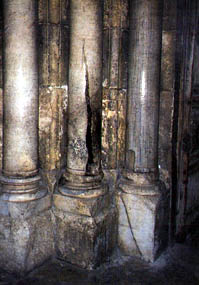
A Moslem Muezin, called Tounom, who saw the miraculous event from an adjacent mosque, abandoned immediately the Moslem religion and became an Orthodox Christian. This event took place in 1579 under Sultan Mourad IV, when the Patriarch of Jerusalem was Sophrony IV. (The mentioned split column still exists. It goes back to the XII c. The Orthodox pilgrims embrace it at the "place of the split" as the enter the church).[2, date and name are corrected]
Turkish warriors stood on the wall of a building close to the gate and lightning-struck column . When he saw this striking miracle he cried that Christ is truly God and /leaped down from a height of about ten meters. But he was not killed--stones under him get as soft as wax and his foot was imprinted in the stones. The Turks tried scrape away these prints but they could not destroy them; they were like witnesses [5].
He was burned by the Turks near the Church. His remains, gathered by the Greeks, had laid in the monastery of Panagia till XIX shedding chrism. ? I do not understand this!
Muslims who deny the Passions, Crucifixion and Resurrection of Christ tried to put obstacles in the way of the miracle. Well known Muslim (!) historian Al Biruni wrote: "… a (note: Muslim) governor brought a copper wire instead of a wick (note: of self lighting oil-lamps), in order that it won't ignite and the whole thing would fail to occur. But as the fire descended, the copper burned."[6]
It was not the only attempt. The report written by the English chronicler, Gautier Vinisauf, describes what happened in the year 1192.
"In 1187, the Saracens under the direction of Sultan Salah ad-Din took Jerusalem. In that year, the Sultan desired to be present at the celebration, even though he was not a Christian. Gautier Vinisauf tells us what happened: "On his arrival, the celestial fire descended suddenly, and the assistants were deeply moved...the Saracens... said that the fire which they had seen to come down was produced by fraudulent means. Salah ad-Din, wishing to expose the imposter, caused the lamp, which the fire from Heaven had lighted, to be extinguished, but the lamp relit immediately. He caused it to be extinguished a second time and a third time, but it relit as of itself. Thereupon, the Sultan, confounded, cried out in prophetic transport: 'Yes, soon shall I die, or I shall lose Jerusalem.'"[7]
Pictures and video / I. Miracle pictures of Holy Fire (Holy Light) in Jerusalem
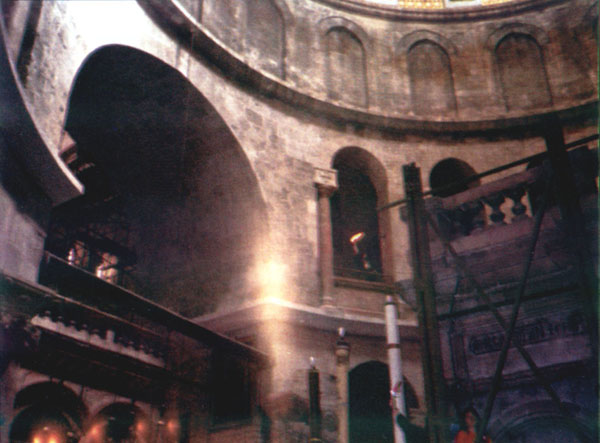
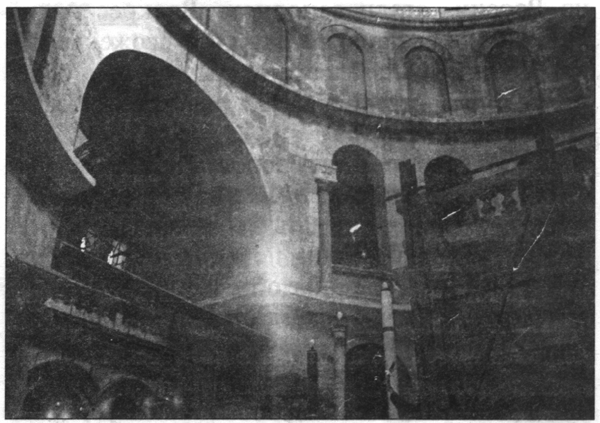
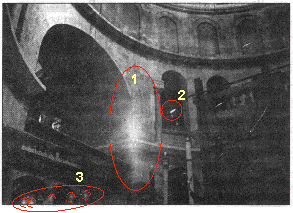
1) In the middle light pillar may be seen, fixed in a moment of the Holy Fire appearance.
2) Candles "itself" have lighten up in an arch in a hand of Armenian clergy.
3) Line of Holy Fire lights may be seen at bottom left. These is not oil-lamps - non-burning oil-lamps may be seen between lights.
Scanned from: © Gubanov Vladimir. Holy Fire: miracles on Holy Sepulchre. Moscow, "Lestvica", ed. 4, 2000, p. 280. Photo made by Blinkov Victor, inking - by author of the site.


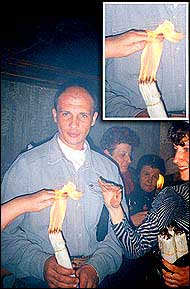
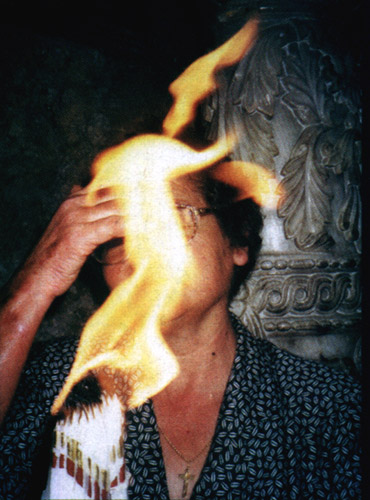
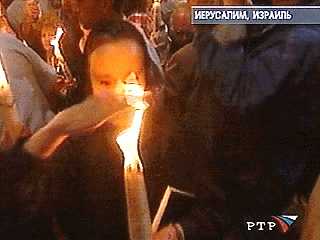
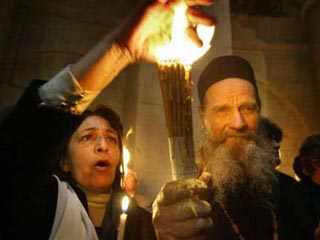
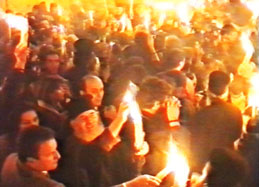
 Luminous haloes See that form of haloes on marvel picture differs: most part of them does not connected with candles or other sources of light. Taken from: Miraclous of Orthodoxy
Luminous haloes See that form of haloes on marvel picture differs: most part of them does not connected with candles or other sources of light. Taken from: Miraclous of Orthodoxy
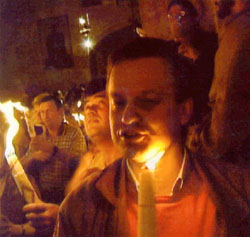
TOPICS: Current Events; Orthodox Christian; Worship
KEYWORDS: catholiclist; holyfire; pascha
Navigation: use the links below to view more comments.
first previous 1-20, 21-40, 41-60, 61-80 ... 101 next last
To: Polycarp IV
PS: I am a sceptic at heart.
21
posted on
04/11/2004 9:16:26 PM PDT
by
Destro
(Know your enemy! Help fight Islamic terrorism by visiting www.johnathangaltfilms.com)
To: mdmathis6; Aliska
In Aliska's article on the other thread it was stated the miracle of the Holy Fire first occurred to a Western monk named St. Bernard in the ninth century. (Click on the Tablet link. It's a good story). Pope Urban pronounced it a miracle. Then the Orthodox became the clergy in charge. The Crusaders built the Church and authority went back and forth for a time.
There are believers and skeptics in both the Eastern and Western Church.
To: Unam Sanctam
NOT me. I think the OC are doing just fine on their own.
My Latin American/Cuban RC son-in-law, says he thinks that the RC church has failed to bring Europeans BACK into the fold. He says the Church sex scandals have been poorly handled as well. I agree with him.
Both of us are very disappointed in the Pope. I had hoped he would have been able to bring France and Germany BACK to Christianity.
The Pope needs to do a lot more in his own backyard/vineyard. If not this Pope then the next one. Probably too late, unfortunately.
23
posted on
04/11/2004 9:47:43 PM PDT
by
Lion in Winter
(I ain't no pussy cat... don't mess with me... ya hear! GRRRRRRrrr)
To: Lion in Winter
Thanks for the mean-spirited response to my expression of good will. Hardly in keeping with the Esater season. Have a blessed and happy Easter anyways.
To: Unam Sanctam
Touchy!! Touchy!
Is Europe the bastion of the RC church or not? My son-in -law is seminary trained and he loves his Church. But we both worry about the loss of the Faithful Flock in Europe.
With islamics moving into Europe by the boatload, things could get ugly fast. Looka at Spain. The man they elected is not a serious Christian. He is a leftist. THIS IS BAD!
The Pope has the power to campaign against the loss of active members. WE WANT HIM TO DO THAT!
He is ill and he keeps on trying, but he is just so ill.
A revival is what the RC needs. It does not the OC Church. I believe that dream of unity is a waste of energy.
25
posted on
04/11/2004 10:33:27 PM PDT
by
Lion in Winter
(I ain't no pussy cat... don't mess with me... ya hear! GRRRRRRrrr)
To: dansangel
ping
26
posted on
04/12/2004 12:05:43 AM PDT
by
.45MAN
("Less Law more Justice")
To: Destro; american colleen; sinkspur; Lady In Blue; Salvation; Polycarp IV; narses; SMEDLEYBUTLER; ...
He is Risen! He is truly Risen! Catholic Ping - let me know if you want on/off this list

27
posted on
04/12/2004 12:50:18 AM PDT
by
NYer
(O Promise of God from age to age. O Flower of the Gospel!)
Comment #28 Removed by Moderator
To: Destro
CSO publishes census figures on religion
online.ie 2004-04-08 12:10:07+01
The Central Statistics Office has reported a massive increase in the number of Muslims and Orthodox Christians in Ireland between 1991 and 2002.
The CSO said there were more than 10,000 Muslims in Ireland at the time of the 2002 census, compared to less than 400 in 1991.
The number of Orthodox Christians in the country also quadrupled to 19,000 in the same period.
Census figures published by the CSO today also showed that the number of Church of Ireland, Methodist and Presbyterian followers in Ireland increased by an average of 2.4%-a-year between 1991 and 2002.
The number of Catholics in the country also increased by 7.3%, though the share of Catholics in the population fell from 91.6% in 1991 to 88.4% in 2002.
29
posted on
04/12/2004 2:54:42 AM PDT
by
MarMema
To: Lion in Winter; Destro; Aliska; Canticle_of_Deborah; All
I am not missing your intentions - all these articles from secular and catholic sources, all the doubts and insinuations posted here about the Holy Fire, posting articles from a year ago and failing to post the date.
My faith comes from those who were there and witnessed it, who spoke with passion of having picked up with their hands bouncing balls of blue light and rubbed the fire balls on their faces, crossed themselves with it, and felt no pain. There are numerous pictures and videos of people doing this kind of thing at the links I posted above. Next time you can do this with fire from a cigarette lighter, get back to me. These implications are nothing more than the evil one, which I can see coming a mile away when it comes to the holy gift here which is given only to the Orthodox church. Cast off the one on your shoulders who whispers to you to doubt and not believe, for even the apostles were weakened by the same father of lies.
You know not of what you speak. May God forgive you for your shallow attempts here to belittle something so sacred and holy, something which does not belong on a website like this, it seems, among people like many posting here. I am sad for you that your faith is so small and twisted. So here is a writing that may help you to remember that God is larger than a cigarette lighter, and larger than two men arguing and the press who enjoyed blowing it out of proportion - something the catholics here certainly know nothing about.
2004.04.07 OCA:
Life in Christ:
A series of Pastoral Reflections
Very Reverend John Breck, Editor
April 2004 Article #1 - "But Some Doubted..."
By Fr John Breck
The "living tradition" of Orthodox Christianity teaches us that nothing is fortuitous, nothing occurs by chance. God is present and acting at every moment and through all things, in order to guide human life and the whole of creation toward fulfillment of His will. This means that He takes upon Himself our struggles and pain, just as He bestows upon us our hope and our joy. In some mysterious way, He also shares in our doubt.
In the biblical accounts, profound meaning is often expressed by small, easily overlooked details. One of the most striking of those details appears at the close of St Matthew's Gospel. In obedience to Christ's command, the disciples leave Jerusalem and come to an unnamed mountain in Galilee. The evangelist continues: "And when they saw Him," the risen Christ, "they worshipped Him. But some doubted."
The other Gospels also bear witness to the doubt experienced by some of those who encountered either the empty tomb or the risen Lord. St Mark's Gospel seems originally to have ended with 16:8. Here the women disciples flee from the tomb with "trembling and astonishmentŠ; and they said nothing to anyone, for they were afraid." The tradition contained in Mark's longer ending (16:14) shows Jesus upbraiding the other disciples "for their unbelief and hardness of heart," because they refused to believe the women's testimony once it was delivered to them.
In his resurrection narrative, St Luke attempts to soften the disciples' reaction with a qualification (24:41): "and while they still disbelieved for joyŠ." Their disbelief, nevertheless, was real.
Finally, the evangelist John focuses the disciples' doubt in the person of Thomas (20:27). It was his unbelief that prompted Jesus to show His hands and side as proof of His bodily resurrection. In response, Thomas uttered the Scriptures' most sublime confession: "My Lord and my God!" Yet later on the disciples continued to doubt, as shown by their reaction to Jesus' appearance on the Sea of Tiberius (21:12).
In his homily on the end of Matthew's Gospel, St John Chrysostom makes a significant point regarding the evangelist's candid admission that some of the disciples doubted, even in the presence of the risen Lord. To Chrysostom, this demonstrates the truthfulness of the tradition, and the willingness on the part of each evangelist to speak frankly of the disciples' weaknesses and shortcomings. 1
Holy Pascha, celebration of Christ's victory over death by the power and glory of His resurrection, most often elicits among Orthodox Christians an unparalleled outpouring of thanksgiving and joy. This response comes to its fullest expression in the Holy Week services, culminating with the midnight paschal office, followed by the Divine Liturgy. Pascha is above all a feast of light and joy, of mutual embracing in mutual forgiveness and reconciliation. It offers a glorious foretaste of the Great Feast, the Everlasting Banquet to come.
Yet with all its brightness and celebration of victory, some doubted then, and some continue to do so even now.
When I look at the poverty of my faith and the paucity of works of love that flow from it, I wonder just how I came to believe in the first place. All it takes is an unpleasant phone call, or too many demands on my time, or simply getting out of the wrong side of bed in the morning, and I find myself in a mild depression. In that state I can't pray - no, the truth is, I simply don't want to pray. I just want to be left alone: by family, by friends, by people in the Church, and maybe above all, by God. Then doubt sets in, not as a rational rejection of the object of my belief, but as an escape from myself and my bad mood, my inability to deal adequately with myself or others in a sinful and fallen world. Doubt in those times is a convenience.
There are other moments, though, when doubt takes on a more insidious form. A news report of thousands killed in an earthquake, or of terrorist bombings that wantonly destroy and maim innocent people, or of priests arrested for child molestation: these things sometimes call up a frustrated and angry question, "Why, God?" "Why do you allow it?" As if I could somehow fathom the mystery of God's workings and will, even if they were revealed to me.
But of all these, the worst is when I allow the faith I have been given by God's grace to be shaken by "thoughts," those demonic voices the Fathers knew so well, that whisper into my ear: "Is it really true?" "Isn't it just a myth, neatly constructed, wrapped and delivered by those who want to believe, and therefore want us to believe, yet whose assertions are less fact than wishful thinking?"
In those most awful moments, it feels as though the substance of my faith is slipping away, that my mind is betraying me by offering some rationalization I can't logically reject. Then life itself seems to be ebbing away, and with it peace, longing, and any sense of hope. Those are the worst times, and they have the power to destroy.
The thread that up to now has somehow bound me to a modicum of faith, despite myself, is the memory of a few holy people and a few holy things I have been blessed to know and experience. The face, wrinkled and radiant, of an old Russian woman who suffered through the Revolution, lost her family in their own holocaust, and spent decades in exile. An icon that wept tears of myrrh and filled the sacred space of the little parish church with the perfume of heaven. A Slavonic Liturgy sung with such power and grace that the presence of myriad angels and saints became palpable. A gesture of wholly disinterested, sacrificial love that exhausted the giver yet brought new life to the one who received. A little child who, many years ago, brought me to tears with the simple question, "Daddy, does God love me as much as he loves you?"
These are the things that work miracles against my doubt. Like the faith I claim, and so often take for granted, they are pure gift, wholly unmerited.
When I feel God and life and truth slipping away into a fog of doubt, there remains that perilously thin thread of memory: the memory of grace, of goodness and of love. Then, because God is infinitely faithful, and because countless souls before me have known and lived in the truth and joy of Christ's resurrection, I find myself able to make the simple confessional prayer we are all invited to make: "Lord, I believe; help me in my unbelief!"
1 - Hom 90.2. See Ancient Christian Commentary on Scripture, New Testament Ib, (Mt. 14-28), ed. M. Simonetti (InterVarsity Press, 2002), p. 312f.
30
posted on
04/12/2004 3:11:36 AM PDT
by
MarMema
Comment #31 Removed by Moderator
Comment #32 Removed by Moderator
To: Destro
Same church - different management. Brother! A blessed Pascha to you and yours, doubly so for this comment!
To: Aliska
Pope Gregory IX banned Roman Catholics from participating in the ceremony in 1238. Never heard that before.
http://www.thetablet.co.uk/cgi-bin/archive_db.cgi?tablet-00736
That article reports that he banned the Franciscan clergy from participating. That sounds more like a matter of mixing of the clergy in religious celebrations, than a ban on the faithful. The same article reports Urban II urged Crusaders at Clermont onwards by recounting the miracle.
To: MarMema
I didn't mean to give offense here, but life has taught me that I must think critically. I posted the other articles because I never accept anything from only one source. I can see the possible bias in the Guardian article, the quoting of only one naysayer, and suspect some bias from catholic sources, but one must press on anyway. Then I saw what Polycarp posted and thought uh oh, this is going to get ugly. But he has a right to post what he finds and we ought to be mature enough to discuss all aspects of this rationally and draw our own conclusions.
The truth trumps all. If it is a true miracle, it will stand the test of scrutiny. Until then, or until I can get there to witness it with my own eyes. I have learned that sometimes even witnesses cannot be trusted. I am *not* accusing your friends of lying, but I do *know* that when you get in a super-charged atmosphere, strange things start happening.
There are aspects of the behavior of those involved that are disturbing, and I am having trouble with *some* of it, not the least of which are the 200 people trampled in the 19th century.
Difficulties:
1. Only the priest and maybe one other priest go into the sealed room. The orthodox are accustomed to this because of their liturgy, but with protestants and catholics, things tend to be done more openly.
2. The petty, childish bickering turf war on the part of those who should know better on all sides.
3. The trampling of the 200.
4. Wondering how the authorities whom I assume are not believers are persuaded to participate and what that is about.
5. The one priest was quoted as admitting he had a lighter, like he needed a backup plan. Blowing out a rival's candle sounds a little childish. Actually I think there is a spiritual message there, too.
I'm truly sorry if I hit a nerve, but here we are talking about fire and I have been badly burned about other things like this, and the last thing I need is to be deceived again, especially by people I don't really know on the internet.
Yes, true to form, I found the positive article in the orthodox newsgroup and gullible little me grabs onto it and thinks this is really wonderful and wishing that it is really true, no matter whose turf it occurred on. Then, true to form from, I start asking *myself* questions and figured if I asked you, you couldn't be objective because of where you are in this. It would be somewhat like asking a Mormon if the golden plates were real.
35
posted on
04/12/2004 7:09:36 AM PDT
by
Aliska
To: Aliska; MarMema; Hermann the Cherusker; Polycarp IV; Destro; Canticle_of_Deborah
Whether the Patriarch requires a lighter or not has no bearing on the holiness of the fire, IMHO. Because all matter and the chemical energy contained in it and the human ingenuity employed in combining them to produce matches and butane lighters are all created by God ex nihilo, and because all are part of the creation redeemed in the Resurrection, the hankering after a timely "new" miracle every year seems somehow to miss the point.
36
posted on
04/12/2004 9:03:53 AM PDT
by
Romulus
("Behold, I make all things new")
To: Canticle_of_Deborah
the miracle of the Holy Fire first occurred to a Western monk named St. Bernard in the ninth century. The credit for the first record of the ceremony goes to a ninth- century Western Christian monk called Bernard who claimed that “an angel comes and kindles light in the lamps which hang above the sepulchre.
I read that as the first recorded historical account known by the author of the article was in the ninth century which doesn't necessarily mean that the holy fire ceremony hadn't been going on centuries before that. Somewhere else I read it started in the 4th century.
37
posted on
04/12/2004 9:18:35 AM PDT
by
Aliska
To: Romulus
There is a difference between how the fire is generated, although you have a good point. In the Book of Acts, it talks about tongues of fire which I never assumed was literal fire but more of a supernatural kind of fire. I don't know if there is a difference or not.
To me the real miracle was the peace and joy described by the pilgrims, which for most Christians, needs rekindling from time to time. If I felt that peace and joy, I wouldn't care much one way or the other about the external firey manifestations.
38
posted on
04/12/2004 9:23:48 AM PDT
by
Aliska
To: Aliska; MarMema; Polycarp IV
The same website that posts pictures of the miracle (which I refrenced) also has that doubting article from the Guardian - Orthodox are not unafraid to be skeptical or to question while praising the miracle.
39
posted on
04/12/2004 9:55:27 AM PDT
by
Destro
(Know your enemy! Help fight Islamic terrorism by visiting www.johnathangaltfilms.com)
To: Romulus; Aliska; MarMema; Hermann the Cherusker; Polycarp IV; Destro; Canticle_of_Deborah
I have read of a more scientific but also miraculous way it is done having to do with spontaneous combustion.
40
posted on
04/12/2004 10:01:25 AM PDT
by
Destro
(Know your enemy! Help fight Islamic terrorism by visiting www.johnathangaltfilms.com)
Navigation: use the links below to view more comments.
first previous 1-20, 21-40, 41-60, 61-80 ... 101 next last
Disclaimer:
Opinions posted on Free Republic are those of the individual
posters and do not necessarily represent the opinion of Free Republic or its
management. All materials posted herein are protected by copyright law and the
exemption for fair use of copyrighted works.
FreeRepublic.com is powered by software copyright 2000-2008 John Robinson
 Christian worshipers surround what is traditionally believed to be the tomb of Jesus Christ, during the Holy Fire ceremony during Easter celebrations at the Church of the Holy Sepulchre in Jerusalem's Old City, Saturday, April 10, 2004. The ceremony is meant to assure the worshippers that Jesus has not forgotten them and is sending a message of hope through the fire. (AP Photo/Brennan Linsley)
Christian worshipers surround what is traditionally believed to be the tomb of Jesus Christ, during the Holy Fire ceremony during Easter celebrations at the Church of the Holy Sepulchre in Jerusalem's Old City, Saturday, April 10, 2004. The ceremony is meant to assure the worshippers that Jesus has not forgotten them and is sending a message of hope through the fire. (AP Photo/Brennan Linsley)  Israeli police in blue uniforms push back pilgrims and Evzones, right, members of the Greek Presidential guard, who escorted Greek Orthodox Patriarch of Jerusalem Irineos I, unseen background right, as he exits the tomb, during scuffles in the Holy Fire ceremony at the Church of the Holy Sepulcher in east Jerusalem's Old City Saturday, April 10, 2004. Thousands of Christian Orthodox pilgrims wait outside the tomb, where Jesus Christ is traditionally believed to be buried, for hours until the Greek Orthodox Patriarch opens the doors carrying the holy flame which is then used to light all the other candles of the faithfull. (AP Photo/Lefteris Pitarakis)
Israeli police in blue uniforms push back pilgrims and Evzones, right, members of the Greek Presidential guard, who escorted Greek Orthodox Patriarch of Jerusalem Irineos I, unseen background right, as he exits the tomb, during scuffles in the Holy Fire ceremony at the Church of the Holy Sepulcher in east Jerusalem's Old City Saturday, April 10, 2004. Thousands of Christian Orthodox pilgrims wait outside the tomb, where Jesus Christ is traditionally believed to be buried, for hours until the Greek Orthodox Patriarch opens the doors carrying the holy flame which is then used to light all the other candles of the faithfull. (AP Photo/Lefteris Pitarakis)  A Greek Orthodox monk, lights the candles of the tomb, where Jesus Christ is traditionally believed to be buried, with Holy Fire following the Holy Fire ceremony in the Church of the Holy Sepulcher at east Jerusalem's Old City Saturday, April 10, 2004. Thousands of Christian Orthodox pilgrims wait outside the tomb for hours until the Greek Orthodox Patriarch opens the doors carrying the holy flame which is then used to light all the other candles of the faithfull. (AP Photo/Lefteris Pitarakis)
A Greek Orthodox monk, lights the candles of the tomb, where Jesus Christ is traditionally believed to be buried, with Holy Fire following the Holy Fire ceremony in the Church of the Holy Sepulcher at east Jerusalem's Old City Saturday, April 10, 2004. Thousands of Christian Orthodox pilgrims wait outside the tomb for hours until the Greek Orthodox Patriarch opens the doors carrying the holy flame which is then used to light all the other candles of the faithfull. (AP Photo/Lefteris Pitarakis)  A Russian Orthodox monk, lifts up candles with Holy Fire as crowds of orthodox Christian worshippers and clergymen light candles with Holy Fire from each other during a ceremony in the Church of the Holy Sepulcher in east Jerusalem's Old City Saturday, April 10, 2004. Thousands of Christian Orthodox pilgrims wait outside the tomb, where Jesus Christ is traditionally believed to be buried, for hours until the Greek Orthodox Patriarch opens the doors carrying the holy flame which is then used to light all the other candles of the faithfull. (AP Photo/Lefteris Pitarakis)
A Russian Orthodox monk, lifts up candles with Holy Fire as crowds of orthodox Christian worshippers and clergymen light candles with Holy Fire from each other during a ceremony in the Church of the Holy Sepulcher in east Jerusalem's Old City Saturday, April 10, 2004. Thousands of Christian Orthodox pilgrims wait outside the tomb, where Jesus Christ is traditionally believed to be buried, for hours until the Greek Orthodox Patriarch opens the doors carrying the holy flame which is then used to light all the other candles of the faithfull. (AP Photo/Lefteris Pitarakis)  The lights of a candlelight procession leave trails as Christian worshippers surround what is traditionally believed to be the tomb of Jesus Christ, during the Holy Fire ceremony during Easter celebrations at the Church of the Holy Sepulchre in Jerusalem's Old City, Saturday, April 10, 2004. (AP Photo/Brennan Linsley)
The lights of a candlelight procession leave trails as Christian worshippers surround what is traditionally believed to be the tomb of Jesus Christ, during the Holy Fire ceremony during Easter celebrations at the Church of the Holy Sepulchre in Jerusalem's Old City, Saturday, April 10, 2004. (AP Photo/Brennan Linsley)  Christian worshippers hold candles at the Holy Fire ceremony during Easter celebrations at the Church of the Holy Sepulchre in Jerusalem's Old City, Saturday, April 10, 2004. The ceremony is meant to assure the worshippers that Jesus has not forgotten them and is sending a message of hope through the fire. (AP Photo/Oded Balilty)
Christian worshippers hold candles at the Holy Fire ceremony during Easter celebrations at the Church of the Holy Sepulchre in Jerusalem's Old City, Saturday, April 10, 2004. The ceremony is meant to assure the worshippers that Jesus has not forgotten them and is sending a message of hope through the fire. (AP Photo/Oded Balilty)  A Christian worshipper holds a candle at the Holy Fire ceremony during Easter celebrations at the Church of the Holy Sepulchre in Jerusalem's Old City, Saturday, April 10, 2004. The ceremony is meant to assure the worshippers that Jesus has not forgotten them and is sending a message of hope through the fire. (AP Photo/Oded Balilty)
A Christian worshipper holds a candle at the Holy Fire ceremony during Easter celebrations at the Church of the Holy Sepulchre in Jerusalem's Old City, Saturday, April 10, 2004. The ceremony is meant to assure the worshippers that Jesus has not forgotten them and is sending a message of hope through the fire. (AP Photo/Oded Balilty)  Christian worshippers and clergymen light candles outside what is traditionally believed to be the tomb of Jesus Christ during the Holy Fire ceremony during Easter celebrations at the Church of the Holy Sepulchre in Jerusalem's Old City, Saturday, April 10, 2004. The ceremony is meant to assure the worshippers that Jesus has not forgotten them and is sending a message of hope through the fire. (AP Photo/Kevin Frayer)
Christian worshippers and clergymen light candles outside what is traditionally believed to be the tomb of Jesus Christ during the Holy Fire ceremony during Easter celebrations at the Church of the Holy Sepulchre in Jerusalem's Old City, Saturday, April 10, 2004. The ceremony is meant to assure the worshippers that Jesus has not forgotten them and is sending a message of hope through the fire. (AP Photo/Kevin Frayer)  Orthodox Christians light candles inside the Church of the Holy Sepulchre during the 'Ceremony of the Holy Fire' in Jerusalem, April 10, 2004. Christian faithfuls believe the church is built on the site of Jesus' last resting place after his body was removed from the cross. The fire is first taken from inside the tomb and then rapidly spreads throughout the ancient church as faithful slight each other's candles. REUTERS/Reinhard Krause
Orthodox Christians light candles inside the Church of the Holy Sepulchre during the 'Ceremony of the Holy Fire' in Jerusalem, April 10, 2004. Christian faithfuls believe the church is built on the site of Jesus' last resting place after his body was removed from the cross. The fire is first taken from inside the tomb and then rapidly spreads throughout the ancient church as faithful slight each other's candles. REUTERS/Reinhard Krause  A Christian worshipper holds candles at the Holy Fire ceremony during Easter celebrations at the Church of the Holy Sepulchre in Jerusalem's Old City, Saturday, April 10, 2004. The ceremony is meant to assure the worshippers that Jesus has not forgotten them and is sending a message of hope through the fire. (AP Photo/Oded Balilty)
A Christian worshipper holds candles at the Holy Fire ceremony during Easter celebrations at the Church of the Holy Sepulchre in Jerusalem's Old City, Saturday, April 10, 2004. The ceremony is meant to assure the worshippers that Jesus has not forgotten them and is sending a message of hope through the fire. (AP Photo/Oded Balilty)  Christian worshippers hold candles as they walk around the Edicule, the place that is traditionally believed to be the tomb of Jesus Christ during the Holy Fire ceremony during Easter celebrations at the Church of the Holy Sepulchre in Jerusalem's Old City, Saturday, April 10, 2004. The ceremony is meant to assure the worshippers that Jesus has not forgotten them and is sending a message of hope through the fire. (AP Photo/Kevin Frayer)
Christian worshippers hold candles as they walk around the Edicule, the place that is traditionally believed to be the tomb of Jesus Christ during the Holy Fire ceremony during Easter celebrations at the Church of the Holy Sepulchre in Jerusalem's Old City, Saturday, April 10, 2004. The ceremony is meant to assure the worshippers that Jesus has not forgotten them and is sending a message of hope through the fire. (AP Photo/Kevin Frayer)  Christian worshipers hold candles during the Holy Fire ceremony during Easter celebrations at the Church of the Holy Sepulchre in Jerusalem's Old City, Saturday, April 10, 2004. The ceremony is meant to assure the worshippers that Jesus has not forgotten them and is sending a message of hope through the fire. (AP Photo/Oded Balilty)
Christian worshipers hold candles during the Holy Fire ceremony during Easter celebrations at the Church of the Holy Sepulchre in Jerusalem's Old City, Saturday, April 10, 2004. The ceremony is meant to assure the worshippers that Jesus has not forgotten them and is sending a message of hope through the fire. (AP Photo/Oded Balilty)  Christian worshipers hold candles during the Holy Fire ceremony during Easter celebrations at the Church of the Holy Sepulchre in Jerusalem's Old City, Saturday, April 10, 2004. The ceremony is meant to assure the worshippers that Jesus has not forgotten them and is sending a message of hope through the fire. (AP Photo/Oded Balilty)
Christian worshipers hold candles during the Holy Fire ceremony during Easter celebrations at the Church of the Holy Sepulchre in Jerusalem's Old City, Saturday, April 10, 2004. The ceremony is meant to assure the worshippers that Jesus has not forgotten them and is sending a message of hope through the fire. (AP Photo/Oded Balilty)  Orthodox Christians light candles inside the Church of the Holy Sepulchre as they celebrate the 'Ceremony of the Holy Fire,' in Jerusalem April 10, 2004. Christian faithful believe the church is built on the site of Jesus' last resting place after his body was removed from the cross. The fire is first taken from inside the tomb and then rapidly spreads throughout the ancient church as the faithful light each other's candles. REUTERS/Goran Tomasevic
Orthodox Christians light candles inside the Church of the Holy Sepulchre as they celebrate the 'Ceremony of the Holy Fire,' in Jerusalem April 10, 2004. Christian faithful believe the church is built on the site of Jesus' last resting place after his body was removed from the cross. The fire is first taken from inside the tomb and then rapidly spreads throughout the ancient church as the faithful light each other's candles. REUTERS/Goran Tomasevic  An Orthodox Christian man lights candles as he pray inside the Church of the Holy Sepulchre as the 'Ceremony of the Holy Fire' is celebrated, April 10, 2004. Christian faithful believe the church is built on the site of Jesus' last resting place after his body was removed from the cross. The fire is first taken from inside the tomb and then rapidly spreads throughout the ancient church as the faithful light each other's candles. REUTERS/Goran Tomasevic
An Orthodox Christian man lights candles as he pray inside the Church of the Holy Sepulchre as the 'Ceremony of the Holy Fire' is celebrated, April 10, 2004. Christian faithful believe the church is built on the site of Jesus' last resting place after his body was removed from the cross. The fire is first taken from inside the tomb and then rapidly spreads throughout the ancient church as the faithful light each other's candles. REUTERS/Goran Tomasevic  Orthodox Christians light candles as they pray inside the Church of the Holy Sepulchre during the 'Ceremony of the Holy Fire,' in Jerusalem April 10, 2004. Christian faithful believe the church is built on the site of Jesus' last resting place after his body was removed from the cross. The fire is first taken from inside the tomb and then rapidly spreads throughout the ancient church as the faithful light each other's candles. REUTERS/Goran Tomasevic
Orthodox Christians light candles as they pray inside the Church of the Holy Sepulchre during the 'Ceremony of the Holy Fire,' in Jerusalem April 10, 2004. Christian faithful believe the church is built on the site of Jesus' last resting place after his body was removed from the cross. The fire is first taken from inside the tomb and then rapidly spreads throughout the ancient church as the faithful light each other's candles. REUTERS/Goran Tomasevic  Orthodox Christians light candles inside the Church of the Holy Sepulchre as the they celebrate the 'Ceremony of the Holy Fire' in Jerusalem, April 10, 2004. Christian devotees believe the church was built on the site of Jesus' last resting place after his body was removed from the cross. The fire is first taken from inside the tomb and then rapidly spreads throughout the ancient church as the faithful light each other's candles. REUTERS/Reinhard Krause
Orthodox Christians light candles inside the Church of the Holy Sepulchre as the they celebrate the 'Ceremony of the Holy Fire' in Jerusalem, April 10, 2004. Christian devotees believe the church was built on the site of Jesus' last resting place after his body was removed from the cross. The fire is first taken from inside the tomb and then rapidly spreads throughout the ancient church as the faithful light each other's candles. REUTERS/Reinhard Krause 










 Luminous haloes See that form of haloes on marvel picture differs: most part of them does not connected with candles or other sources of light. Taken from: Miraclous of Orthodoxy
Luminous haloes See that form of haloes on marvel picture differs: most part of them does not connected with candles or other sources of light. Taken from: Miraclous of Orthodoxy 
